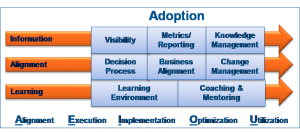I wrote a blog about a year ago “Avoiding pitfalls in strategy execution”, highlighting an article I had read in HBR. Last week I stumbled upon another article “Execution is a People Problem, Not a Strategy Problem” and my first thought was – YES!! it’s all about that “E” (Execution) in AEIOU! This article really hit home by articulating that developing a good strategy (no matter how good it is) is worthless unless it is successfully executed.
We often talk about companies spending millions of dollars on the Foundation (we refer to People, Process and Technology as the consonants in a language):
With the hope of achieving exceptional business results. Unfortunately, little attention is paid to the vowels (AEIOU) – ensuring that whatever is “designed” as part of the foundation is successfully executed / implemented and then UTILIZED – Adoption!!!!

I wish I had even a penny for all the strategies, processes, tools, technology I have built with clients only to discover months / years later that they are not being fully utilized. While we insist on having an adoption bridge in place, it requires a strong leader to ensure that the organization stays the course. A strategic plan is GREAT but it must be accompanied by an execution roadmap that is articulated and FOLLOWED. The article points out that “however hard it is to devise a smart strategy, it’s ten times harder to get people to execute on that strategy and a poorly executed strategy, no matter how clever, is worthless. . . . while strategy development and communication are about knowing something, strategy execution is about doing something. And the gap between what you know and what you do is often huge.”
According to the article, “to deliver stellar results, people need to be hyperaligned and laser-focused on the highest-impact actions that will drive the organizations most important outcomes.” In other words, prioritize! You start by identifying the most important outcome for your company and get everyone aligned around that outcome – Business Alignment. Next, identifying the most important behavior to achieving that outcome is critical. This will allow you to identify those people that will have the greatest capacity to move the strategy forward. We all know people that are highly intelligent, say all the right things and know what needs to be done BUT they do not have the behavioral qualities to “get it done”. Finding the right people AND identifying each individual’s ONE key strength that will allow them to be a major contributor in the execution is important as well. This forces each person to be laser-focused – collectively many individuals are utilizing their biggest strength and contributing to the whole.
Next, coaching is used to ensure that each individual is making progress on their key contribution. The coaching process serves two purposes. One purpose is to ensure forward momentum but the other is to identify organizational issues, barriers and resistance that need to be dealt with by the leadership team – Change Management.
Execution, which is part of our ADOPTION model always TRUMPS strategy. There is no ROI in developing a strategy but rather the successful execution of that strategy. It’s not about what you know but what you DO. Whether it is introducing a new process or technology or talent management program, you must focus on ensuring that it will be ADOPTED. Adoption relies on people embracing the change and making it part of their daily routine. So, as you are developing your strategy(s) for 2017, make sure you have a roadmap in place to ensure execution and adoption.


3 Comments
Pingback: Do You Know the Difference Between Strategic Sourcing and Category Management – Create a Fail-Safe Environment - News You Can Use
Pingback: Why Do We Always Underestimate Change Management Issues? - News You Can Use
Pingback: Why You Might Need Some Governance - News You Can Use